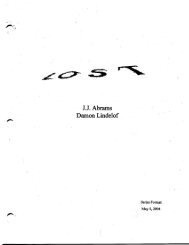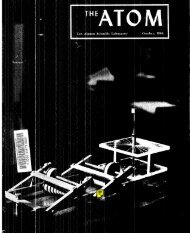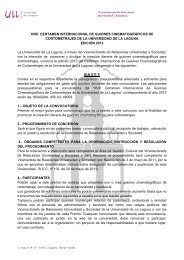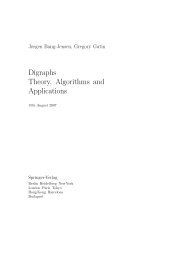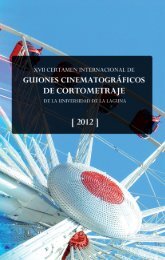Create successful ePaper yourself
Turn your PDF publications into a flip-book with our unique Google optimized e-Paper software.
Figure 6<br />
owner of a perpetual engine! You<br />
don't believe me? We1l, I'll prove it<br />
mathematically.<br />
Place two equally heated bodies<br />
at points F, and Fr. Notice that any<br />
ray lof light or heat) issuing from F,<br />
must arrive atFzffig.6l. Aray propagated<br />
along the same trajectory from<br />
F, will arrive back at F, of course.<br />
But look at a ray aimed frorn F, at<br />
the vertical barrier. If there were no<br />
partition, this ray would rebound<br />
from the erased part of the ellipse<br />
and hit Fr. But now it will be reflected<br />
at some point R of the partition<br />
in the direction it would have<br />
had if it had propagated from F, to R<br />
(fig. 6). Therefore, it will come back<br />
to Fr! And, clearly,leaving point F,<br />
along the same trajectory in the opposite<br />
direction, we again come<br />
back to Fr. So there's a considerable<br />
number of rays that make "light<br />
loops." In the cross section of our<br />
"engine" shown in figure 5, these<br />
are aLL the rays within the angle<br />
AFrB and the symmetric angle<br />
A',FzB'..<br />
So, the body at F, will be heated,<br />
while the body at F, willbe cooled.<br />
We can even compute the eventual<br />
temperatures of the bodies after the<br />
process stabilizes.<br />
Suppose the initial temperatures<br />
were 7o K (or "kelvins," named after<br />
the English physicist W. Thomson<br />
mentioned above, on whom the<br />
title of Lord Kelvin was con{erred for<br />
his outstanding scientific achievements).<br />
It's known that the rate of<br />
energy loss by radiation (the luminosity)<br />
is proportional to the fourth<br />
power o{ the temperature (in<br />
kelvins) of the radiating body.<br />
Therefore, if the temperature at<br />
Figure 7<br />
point F, is 7r, and at Frit's Tr, then<br />
the luminosity at F, and F, canbe<br />
written as k( andkTf , respectively.<br />
A11 the rays from F, after one reflection<br />
arrive at F,b:ut only some of<br />
the rays from F, arrive at Fr. How<br />
many? Consider a small sphere centered<br />
atFr. The rays that return to F,<br />
cut a ring out of this sphere lfi4. Tl-<br />
If its area is A, and the total area of<br />
the sphere is A, than the amount of<br />
radiation that comes back to F,<br />
equals ArkTtlA, and the portion<br />
that arrives at F, is (A - A)kftlA.<br />
In the steady state, the energy radiated<br />
from point F, equals the energy<br />
that arrives at this point in the<br />
same time interval. That is,<br />
(o- +)U = krl.<br />
\t/A<br />
On the other hand, by the law of<br />
conservation of energy, the loss of<br />
energy atF, equals the gain of energy<br />
atFz-thatis, C(7, -Tol: ClTo-721,<br />
where C is the heat capacity of either<br />
body,(we assume that the bodies<br />
are absolutely alike). The last<br />
equation gives 7, + Tr:2T0, so using<br />
the previous relationship and<br />
letting b = l(A - Ar) I A| la, andnoting<br />
that b < 1, we finally get<br />
T,<br />
'<br />
=T&.To, r+b<br />
2T^<br />
"= ri"o'<br />
That's it! You can check the reasoning<br />
from the very beginning and<br />
be satisfied that it's perfectly correct.<br />
So, did we really refute the second<br />
law of thermodynamics? Unfortunately<br />
(or fortunately), no. We've<br />
made a mistake. But where? Think<br />
about it yourself, and then compare<br />
your answer with what's written<br />
below. I have a feeling that not every<br />
reader will be able to find the<br />
correct answer.<br />
You were on the wrong track if<br />
you tried to find an error in the physics-for<br />
instance, in the fact that we<br />
ignored convection. Why? We can<br />
cteate a vacuum inside the shell. But<br />
what else is there in our little "engine"<br />
except math and physics? The<br />
error is hiding at the border, so to<br />
speak, between these two sciencesin<br />
the transition from the physical<br />
process to its mathematical model.<br />
Recall that we dealt with two<br />
bodies placed at the foci. Thus, we<br />
neglected the sizes of the bodies.<br />
This is common in physics reasoning,<br />
and the phrase "a body is 1ocated<br />
at point M" doesn't cause<br />
anyone to protest. In many situations,<br />
this disregard of the sizes of<br />
the bodies is justifiable. For instance<br />
the motion of a body under given<br />
forces applied to its center of mass<br />
doesn't depend on its size and<br />
shape. Or, as Newton showed, a<br />
body consisting of a number of concentric<br />
homogeneous spherical layers<br />
attracts other bodies as the same<br />
mass concentrated at the center of<br />
this body. So to reptrace a body with<br />
a point is indeed a customary operation<br />
in physics.<br />
But in our case this operation<br />
leads to an error. Let's see whether<br />
our reasoning remains valid if we<br />
consider balls of nonzero radius centered<br />
at the foci.<br />
Consider three rays reflected from<br />
the ellipse at the same point M in its<br />
left half (fig. B): a ray issuing from the<br />
foci F, and two rays, AM arrd BM,<br />
with endpoints at a distancer fr.or;-i,Fr.<br />
M<br />
IB<br />
Figure B<br />
Y',<br />
OUANTUllll/IIATUBE



